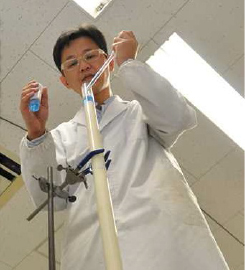 Profile
ProfileAssociate Professor, Plant glycobiology, Area of Biochemistry and Molecular Biology, Division of Life Science, Graduate School of Science and Engineering
|
March 1995 |
Graduation from the Faculty of Integrated Arts and Sciences, Hiroshima University |
|---|---|
|
Between April 1997 and March 2000 |
Research fellow (DC) of the Japan Society for the Promotion of Science |
|
March 2000 |
Received PhD degree from the Graduate School of Biosphere Science, Hiroshima University |
|
Between April and December 2000 |
Postdoctoral fellow at the Research Institute for Biological Sciences, Okayama |
|
Between January and June 2001 |
Research fellow of the Japan Science and Technology Corporation |
|
July 2001~ |
Associate professor after the period of assistant and assistant professor at the Graduate School of Science and Engineering, Saitama University |
– Elucidate the Unresolved Phenomena of the Plant Cell Wall –
What is present in the plant cell, but is absent in animal cells? What comes to mind first may be the cell wall or chloroplast. The cell wall determines the shapes and sizes of plant cells. Besides the chloroplasts, the cell wall characterizes plants. In fact, the cell wall supports the bodies of huge trees, produce fluffy cotton, and provide crisp texture to fruits. Since ancient times, human beings have utilized the cell wall for fuels (e.g., firewood), clothes (e.g., hemp and cotton), foods, and paper. How is the cell wall constructed? To address this question, we have focused on sugar nucleotides.
The cell wall is mainly composed of polysaccharides, such as cellulose, hemicellulose, and pectin. Sugar nucleotides are raw materials for the synthesis of these polysaccharides. For example, cellulose and xylan are synthesized from UDP-glucose and -xylose, respectively. We recently discovered novel enzymes for the synthesis of various sugar nucleotides. The existence of novel enzymes suggests the existence of unknown chemical reactions (enzymes are proteins that catalyze chemical reactions). Plants with cell walls should have developed a mechanism to synthesize sugar nucleotides during evolution. Currently, we are also developing plants suitable for biofuel, plants suitable for forcing culture, and plants resistant to environmental stress.
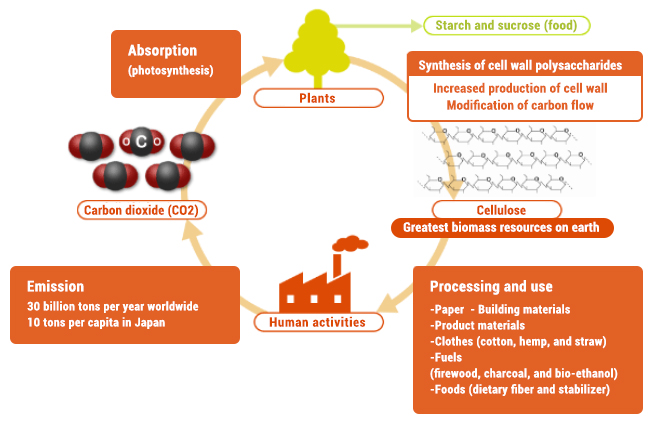
Finally, carbons assimilated by photosynthesis mostly turn into cell wall polysaccharides through sugar nucleotides.
Plants absorb carbon dioxide through photosynthesis. The carbon dioxide mostly turns into sugar nucleotides within the cell to be used for the synthesis of cell wall polysaccharides (e.g., cellulose, hemicellulose, and pectin).
Artificially regulating the synthesis and metabolism of sugar nucleotides may increase the synthesis of cell wall polysaccharides by plants.
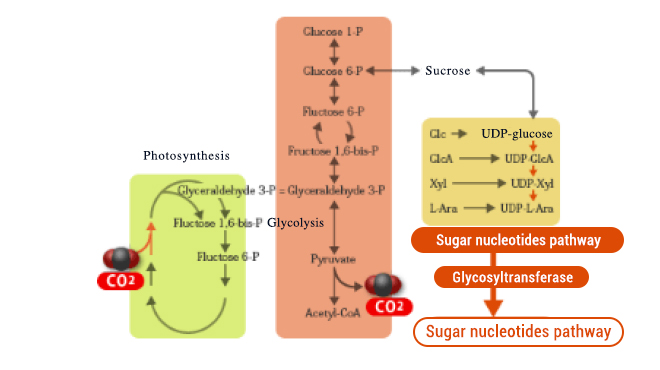
The synthesis of cell wall polysaccharides is controlled at the level of sugar nucleotides and by glycosyltransferase activity.
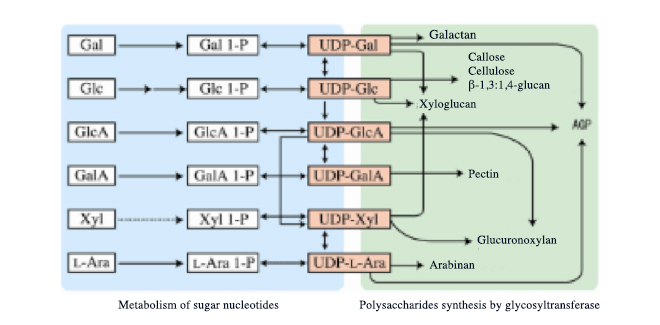
Sugar nucleotides are raw materials for cell wall polysaccharides Plant cell walls contain various polysaccharides, such as xyloglucan, a kind of hemicellulose, and glucuronoxylan, as well as cellulose. All of them are synthesized from certain sugar nucleotides. Activating or suppressing the synthesis and metabolism of sugar nucleotides can increase or decrease the accumulation of polysaccharide
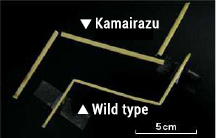 Flow of carbon assimilation and synthetic pathway of sugar nucleotides
Flow of carbon assimilation and synthetic pathway of sugar nucleotidesThe strength of the stem (internode) of Kamairazu, a rice mutant, is so reduced that the stem is torn off easily when bent.
 Electron micrographs: Collaboration with Professor Yasuko Kaneko of the Faculty of Education
Electron micrographs: Collaboration with Professor Yasuko Kaneko of the Faculty of Education
We discovered a novel enzyme producing sugar nucleotides, UDP-sugar pyrophosphorylase.
This enzyme was given an enzyme number EC2.7.7.64 by the Nomenclature Committee of the International Union of Biochemistry and Molecular Biology.
Kamairazu mutant of rice, as the name implies (no need for sickle), is a mutant that is broken and torn off easily by hand. This mutant has a thin cell wall because of the abnormal synthesis and construction of the cell wall.
If the phenomena of Kamairazu mutant can be reversed, plants that can synthesize larger amounts of cell wall polysaccharides from carbon dioxide can be created.
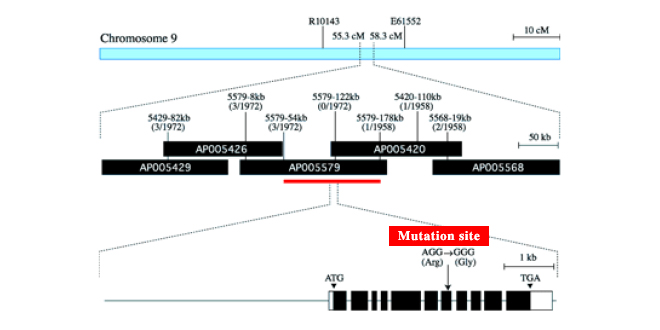
The difference in the gene sequences between japonica and indica cultivars of rice was utilized to identify a causative locus (address). Kamairazu mutant (Bc6) was found to have an abnormal catalytic subunit of cellulose synthase.
Arabinogalactan protein (AGP) is a signaling molecule that functions outside of the cell. AGP is involved in various phenomena, such as the growth, differentiation, reproduction, and stress tolerance of plants. We utilize a degrading enzyme that acts specifically on the carbohydrate moiety of AGP to elucidate the functions of AGP.
Subjects of AGP research

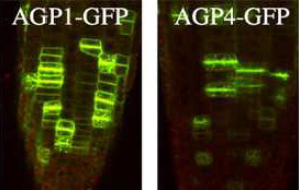 Visualization of AGP
Visualization of AGPElucidate the physiological functions of AGP sugar chains

*For information of enzymes, visit Expacy’s website (http://enzyme.expasy.org/).
 What you can do for yourselves is limited. To advance our research, advice from colleagues and collaborators regarding strategies, useful materials and samples, and interesting findings hidden in failures, are important.
What you can do for yourselves is limited. To advance our research, advice from colleagues and collaborators regarding strategies, useful materials and samples, and interesting findings hidden in failures, are important.
Our research is supported by many people, including Professor Tsumuraya (a distinguished researcher of AGP), my mentor and friends, and collaborators. Seeking their advices when something goes wrong is also a fun in research.


© Copyright Saitama University, All Rights Reserved.